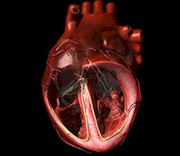Related terms: infection of the heart, endocardium, bacterial endocarditis,
subacute bacterial endocarditis (SBE)
Infective endocarditis is an infection of the lining of the heart's chambers (called the endocardium) or the heart's valves. If left untreated, endocarditis can cause other complications, such as a blood clot (embolism), an irregular heartbeat (arrhythmia), valve damage or destruction, and, in time, congestive heart failure (CHF).
What causes infective endocarditis?
The infection that leads to endocarditis can be caused by bacteria, fungi, or other microorganisms that enter your bloodstream. (You may have heard the term bacterial endocarditis, subacute bacterial endocarditis, or SBE. These terms are used for endocarditis caused only by bacteria—usually group A strep—and not by other microorganisms.)
Normally, microorganisms live on your skin, in your mouth, in your intestines, and in your urinary tract, but not in your blood. Sometimes, however, microorganisms can enter your bloodstream (for example, during a surgical or dental procedure).
For most people, microorganisms in the bloodstream do not pose a problem. But if one of your heart valves becomes damaged, your body sends immune cells, platelets, and fibrin (a clotting material) to heal the valve. This healing process can lead to endocarditis if any microorganisms in your bloodstream become trapped under the layers of these cells. The trapping of microorganisms leads to the development of "clumps" of tissue within the heart and on the heart's valves. These clumps are called vegetations.
Vegetations are dangerous because they can break off and enter the bloodstream. This process is called embolization. If the embolus (the clump that breaks off) is large enough, it can block a blood vessel. This blockage can slow the flow of oxygen-rich blood to parts of your body.
Who is at risk for developing infective endocarditis?
You are more likely to get endocarditis if you already have other heart problems or you have heart valve damage. Endocarditis is more common in people older than 50, and men are affected more often than women.
Your risk for developing endocarditis is increased if
- You have valve disease.
- You have had a heart valve replaced.
- You have a congenital heart defect (a heart defect that you were born with).
- You had rheumatic fever or rheumatic heart disease as a child, which scarred your heart valves.
- You have hypertrophic cardiomyopathy (enlarged or thickened heart walls).
- You are an intravenous drug user.
What are the symptoms?
If you have acute endocarditis, meaning the infection has happened recently, you may feel like you have the flu, with a fever, night sweats, muscle aches and pains, and decreased energy.
If you have chronic endocarditis, which may last for months, you may feel feverish and chilled, be very tired, lose weight, and have joint pain, night sweats, or the symptoms of heart failure.
Other symptoms may include red spots on the palms of your hands and the soles of your feet (called Janeway lesions), or red, painful sores on the tips of your fingers and toes (called Osler's nodes).
How is infective endocarditis diagnosed?
Most doctors will suspect infective endocarditis if you tell them your symptoms and if you have a history of congenital heart disease, rheumatic fever, or valve disease. Doctors may also look for small, dark lines under your fingernails that look like wood splinters (called splinter hemorrhages) or burst blood vessels in the retina of your eyes (called Roth's spots).
With a stethoscope, a doctor can listen to your chest for the distinct sound of a new heart murmur or a change in the sound of an old heart murmur. Heart murmurs are caused by the sound of faulty heart valves and by certain defects in your heart.
Blood samples from different areas of your body can tell doctors if you have microorganisms in your bloodstream. The samples are placed on what is called a culture, where the organism can grow so that it can be analyzed and identified.
Echocardiography can be used to see valve structure and function, heart wall motion, and overall heart size. This is by far the most reliable way to diagnose infective endocarditis.
Other imaging techniques such as transesophageal echocardiography (TEE), computed tomography (CT) scanning, and magnetic resonance imaging (MRI) may be used for a more complete diagnosis or to find out if you have other complications.
How is infective endocarditis treated?
Medicines called antibiotics, which kill the microorganisms, are the first line of treatment for infective endocarditis. If vegetations have damaged your heart valves, you may need surgery.
Lifestyle Changes
Doctors
used to give anyone with a heart murmur antibiotics before a dental or surgical
procedure. (Procedures which may allow bacteria to enter the bloodstream.)
Today, most doctors believe that only patients who have had a heart valve
replaced, who have had endocarditis, who
have congenital heart defects or documented valve disease (such as mitral valve
prolapse), or patients with hypertrophic cardiomyopathy need to take
antibiotics before a dental or surgical procedure. Talk with your doctor or
dentist about current guidelines.
Medicines
Antibiotics are used to kill the microorganisms in your bloodstream and within the vegetations in your heart. The antibiotics you will be given depend on what kind of microorganism has caused your infection. At first, you will need to stay in the hospital, because these strong medicines need to be given through a needle in a vein (intravenously). You will have regular blood tests to see if the medicine is working, and you may need to take these antibiotics for up to 6 weeks.
Surgical Procedures
In some patients, endocarditis can totally damage a heart valve. In these cases, your doctor may recommend surgery to repair or replace the damaged valve.
See also on this site:
See on other sites:
MedlinePlus
https://medlineplus.gov/ency/article/001098.htm
Endocarditis
American Heart Association
www.heart.org/HEARTORG/Conditions/CongenitalHeartDefects/
TheImpactofCongenitalHeartDefects/Infective-Endocarditis_UCM_307108_Article.jsp
Infective Endocarditis
Updated August 2016



